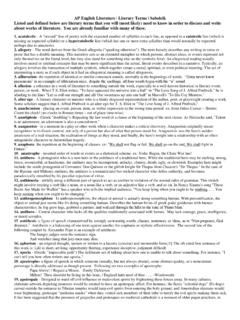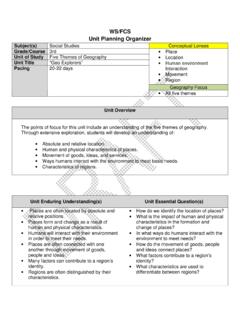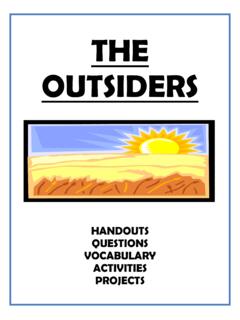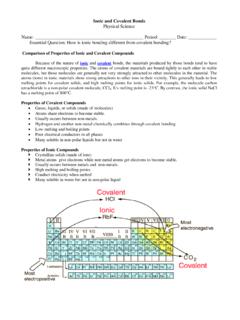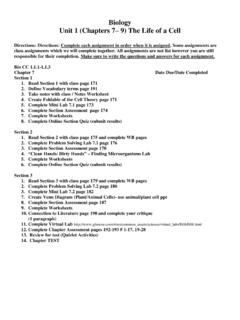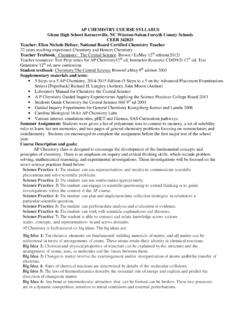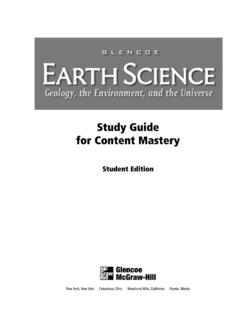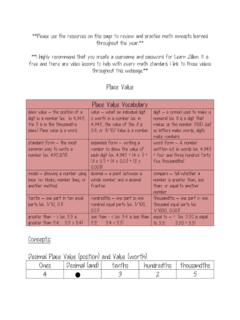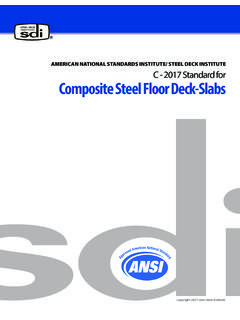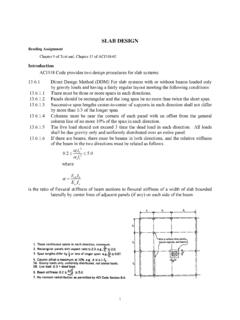Transcription of Plate Tectonics: Earth’s surface is dramatically reshaping ...
1 Plate Tectonic Movements Name: _____ Period: ____ Date: _____ EQ: How is Earth s crust changed by Plate movements? Plate Tectonics: Welcome to the greatest show on Earth. Propelled by intense heat simmering beneath the crust or the mantle, Earth s surface is dramatically reshaping itself in an endless, slow-motion movement called Plate tectonics. Tectonic plates or huge slabs of solid rocks separate, collide, and slide past each other causing earthquakes, feeding volcanic eruptions, and raising mountains. Scientists now have a fairly good understanding of how the plates move and how such movements relate to earthquake activity. Most movement occurs along narrow zones between plates, Plate boundaries, where the results of Plate -tectonic forces are most evident. Types of Plate boundaries: 1. Divergent boundaries -- where new crust is generated as the plates pull away or separates from each other. Examples: mid ocean ridge, rift valleys 2. Convergent boundaries -- where crust come together.
2 One crust is destroyed as it dives under another, known as subduction. Examples: subduction, Marianas trench, mountains, volcanoes 3. Transform boundaries -- where crust is neither produced nor destroyed as the plates slide horizontally past each other. Example: San Andreas fault Plates Move Apart: Divergent Boundary Atlantic ocean, along a global system of mountain ridges, Earth s plates are growing and spreading apart. Each year these oceanic spreading ridges erupt more than three times as much molten rock as do all the volcanoes on land. Magma rises from Earth s mantle at spreading ridges and cools on and beneath the ocean floor , adding to the plates on either side. The growing plates inch away from the ridges widening ocean basins and rafting apart entire continents. _____ Plates Come Together: Convergent Boundary Where plates come together, or converge, we see some dramatic manifestations of Plate tectonics. At convergent margins, continents grow as plates are consumed.
3 Three types of Convergent Boundaries 1. Convergent boundary between continental and oceanic crust results to subduction, volcanoes, and trenches. 2. Convergent boundary between two oceanic crust results to subduction, and the trenches formed are deeper like the Marianas Trench, which can sink Mt. Everest. 3. Convergent boundary between two continental crust results to building up the rocks forming mountains like the Appalachian and Himalayas mountain ranges. Plates Pass By: Transform Boundary Why do earthquakes shake California? The state straddles two plates that are moving past each other like trains on opposite tracks. The Plate boundary is marked by a zone of active faults breaks in the rock and ground surface caused by Plate movements. The most famous of these is the 1200-km (750-mi) long San Andreas Fault. The San Andreas fault is a transform fault, a kind common on the sea floor but rarely found on land. Clarifying Questions: 1. What is Plate tectonics?
4 _____ _____ 2. How is the earth s surface affected by the movement of the tectonic plates? _____ _____ 3. Where do most movements happen in the Earth s crust? _____ _____ 4. What are three types of Plate boundaries? _____ _____ 5. Matching type: Plate Boundaries _____ Convergent boundary a. Mid-ocean ridges, rift valleys _____ Divergent boundary b. Fault lines _____ Transform boundary c. Subduction, trench, mountains, volcanoes 6. Matching type: Plate Boundaries _____ Convergent boundary a. Tectonic plates move apart. _____ Divergent boundary b. Tectonic plates come together. _____ Transform boundary c. Tectonic plates slide horizontally past each other. 7. Matching type: Plate Boundaries _____ Convergent boundary a. Himalayas and the Appalachian mountain ranges _____ Divergent boundary b. San Andreas Fault _____ Transform boundary c. Atlantic mid ocean ridge, African rift valley 8. Matching type: Convergent boundaries _____Continental to oceanic a.
5 Subduction, volcanoes, and trenches _____Oceanic to oceanic b. Subduction, deeper trenches, volcanoes _____Continental to continental c. Mountain ranges like the Appalachian and Himalayas 9. Why do earthquakes shake California? _____ _____ 10. What is the San Andreas Fault? _____ _____ 11. Identify and illustrate the movements of the different types of Plate boundaries Use arrows to indicate directions. _____ _____ _____ R. Angat Matching Type Key: 12. Matching type: Plate Boundaries __C___ Convergent boundary a. mid ocean ridges, rift valleys __A__ Divergent boundary b. fault lines __B___ Transform boundary c. subduction, trench, mountains, volcanoes 13. Matching type: Plate Boundaries __B___ Convergent boundary a. tectonic plates move apart __A___ Divergent boundary b. tectonic plates come together __C___ Transform boundary c. tectonic plates slide horizontally past each other 14. Matching type: Plate Boundaries __A___ Convergent boundary a.
6 Himalayas and the Appalachian mountain ranges __C___ Divergent boundary b. San Andreas fault __B___ Transform boundary c. Atlantic mid ocean ridge, African rift valley 15. Matching type: Convergent boundaries __A___Continental to oceanic a. subduction, volcanoes, and trenches __B___Oceanic to oceanic b. subduction, deeper trenches, volcanoes __C___Continental to continental c. mountain ranges like the Appalachian and Himalayas
